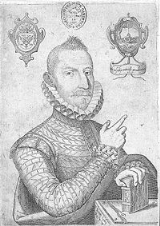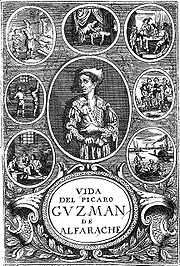
Mateo Alemán
Encyclopedia

Seville
Seville is the artistic, historic, cultural, and financial capital of southern Spain. It is the capital of the autonomous community of Andalusia and of the province of Seville. It is situated on the plain of the River Guadalquivir, with an average elevation of above sea level...
, Spain
Spain
Spain , officially the Kingdom of Spain languages]] under the European Charter for Regional or Minority Languages. In each of these, Spain's official name is as follows:;;;;;;), is a country and member state of the European Union located in southwestern Europe on the Iberian Peninsula...
, 1547 – 1615? in Mexico
Mexico
The United Mexican States , commonly known as Mexico , is a federal constitutional republic in North America. It is bordered on the north by the United States; on the south and west by the Pacific Ocean; on the southeast by Guatemala, Belize, and the Caribbean Sea; and on the east by the Gulf of...
) was a Spanish
Spain
Spain , officially the Kingdom of Spain languages]] under the European Charter for Regional or Minority Languages. In each of these, Spain's official name is as follows:;;;;;;), is a country and member state of the European Union located in southwestern Europe on the Iberian Peninsula...
novel
Novel
A novel is a book of long narrative in literary prose. The genre has historical roots both in the fields of the medieval and early modern romance and in the tradition of the novella. The latter supplied the present generic term in the late 18th century....
ist and writer.
He graduated at Seville University
University of Seville
The Universidad de Sevilla or University of Seville, in English, is a top-ranked European university in Seville, Spain. Founded under the name of Colegio Santa María de Jesús in 1505, the University of Seville, with a student body of over 50,000, is one of the top-ranked universities in the country...
in 1564, studied later at Salamanca
Salamanca
Salamanca is a city in western Spain, in the community of Castile and León. Because it is known for its beautiful buildings and urban environment, the Old City was declared a UNESCO World Heritage Site in 1988. It is the most important university city in Spain and is known for its contributions to...
and Alcalá
Alcalá de Henares
Alcalá de Henares , meaning Citadel on the river Henares, is a Spanish city, whose historical centre is one of UNESCO's World Heritage Sites, and one of the first bishoprics founded in Spain...
, and from 1571 to 1588 held a post in the treasury; in 1594 he was arrested on suspicion of malversation, but was speedily released. According to some authors, he was descended from Jews forcibly converted to Catholicism after 1492, and one of his forebears had been burned by the Inquisition
Inquisition
The Inquisition, Inquisitio Haereticae Pravitatis , was the "fight against heretics" by several institutions within the justice-system of the Roman Catholic Church. It started in the 12th century, with the introduction of torture in the persecution of heresy...
for secretly continuing to practise Judaism. In 1599, he published the first part of Guzmán de Alfarache
Guzmán de Alfarache
Guzmán de Alfarache is a picaresque novel written by Mateo Alemán and published in two parts: the first in Madrid in 1599 with the title Primera parte de Guzmán de Alfarache, and the second in 1604, titled Segunda parte de la vida de Guzmán de Alfarache, atalaya de la vida humana.The works tells...
, a celebrated picaresque novel
Picaresque novel
The picaresque novel is a popular sub-genre of prose fiction which is usually satirical and depicts, in realistic and often humorous detail, the adventures of a roguish hero of low social class who lives by his wits in a corrupt society...
which passed through no less than sixteen editions in five years; a spurious sequel was issued in 1602, but the authentic continuation did not appear until 1604.

Seville
Seville is the artistic, historic, cultural, and financial capital of southern Spain. It is the capital of the autonomous community of Andalusia and of the province of Seville. It is situated on the plain of the River Guadalquivir, with an average elevation of above sea level...
at the end of 1602.
In 1608, Alemán emigrated to America
North America
North America is a continent wholly within the Northern Hemisphere and almost wholly within the Western Hemisphere. It is also considered a northern subcontinent of the Americas...
, and is said to have carried on business as a printer in Mexico
Mexico
The United Mexican States , commonly known as Mexico , is a federal constitutional republic in North America. It is bordered on the north by the United States; on the south and west by the Pacific Ocean; on the southeast by Guatemala, Belize, and the Caribbean Sea; and on the east by the Gulf of...
. His Ortografía castellana (1609), published in that city, contains ingenious and practical proposals for the reform of Spanish
Spanish language
Spanish , also known as Castilian , is a Romance language in the Ibero-Romance group that evolved from several languages and dialects in central-northern Iberia around the 9th century and gradually spread with the expansion of the Kingdom of Castile into central and southern Iberia during the...
spelling. Nothing is recorded of Alemán after 1609, but it is sometimes asserted that he was still living in 1617.
He is the author of a life (1604) of St. Anthony of Padua, and versions of two odes of Horace
Horace
Quintus Horatius Flaccus , known in the English-speaking world as Horace, was the leading Roman lyric poet during the time of Augustus.-Life:...
bear witness to his taste and metrical accomplishment. His most famous work, however, is Guzmán de Alfarache
Guzmán de Alfarache
Guzmán de Alfarache is a picaresque novel written by Mateo Alemán and published in two parts: the first in Madrid in 1599 with the title Primera parte de Guzmán de Alfarache, and the second in 1604, titled Segunda parte de la vida de Guzmán de Alfarache, atalaya de la vida humana.The works tells...
, which was translated into French
French language
French is a Romance language spoken as a first language in France, the Romandy region in Switzerland, Wallonia and Brussels in Belgium, Monaco, the regions of Quebec and Acadia in Canada, and by various communities elsewhere. Second-language speakers of French are distributed throughout many parts...
in 1600, into Italian
Italian language
Italian is a Romance language spoken mainly in Europe: Italy, Switzerland, San Marino, Vatican City, by minorities in Malta, Monaco, Croatia, Slovenia, France, Libya, Eritrea, and Somalia, and by immigrant communities in the Americas and Australia...
in 1606, into German
German language
German is a West Germanic language, related to and classified alongside English and Dutch. With an estimated 90 – 98 million native speakers, German is one of the world's major languages and is the most widely-spoken first language in the European Union....
in 1615, into English
English language
English is a West Germanic language that arose in the Anglo-Saxon kingdoms of England and spread into what was to become south-east Scotland under the influence of the Anglian medieval kingdom of Northumbria...
in 1623 by James Mabbe
James Mabbe
James Mabbe or Mab was an English scholar and poet, and a Fellow of Magdalen College, Oxford. He was involved in translations from Spanish, in particular of some of the work of Cervantes...
, and into Latin
Latin
Latin is an Italic language originally spoken in Latium and Ancient Rome. It, along with most European languages, is a descendant of the ancient Proto-Indo-European language. Although it is considered a dead language, a number of scholars and members of the Christian clergy speak it fluently, and...
in 1623.
"Debe desear todo hombre para saber, y saber para bien vivir"
See J. Hazañas y la Rua, Discursos leidos en la Real Academia Sevillana de Buenas letras el 25 de marzo de 1892 (Sevilla, 1892); J. Gestoso y Perez, Nuevos datos para ilustrar las biografías del Maestro Juan de Malara y de Mateo Alemán (Sevilla, 1896).

